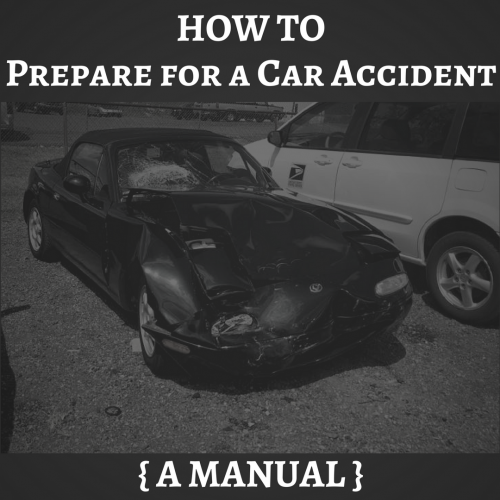How to Prepare for a Car Accident
No one wakes up expecting to get in a car accident.
My mom certainly didn’t, when she woke up on Thursday.
Yet she’s been preparing for that moment of impact for YEARS.

Fortunately for her and for her family, my mom has been sustaining an impressive baseline of health.
::She eats mostly whole, unprocessed foods.
::She supplements intelligently.
::She engages in lots of low-level activity, some moderate-level activity, and even a wee bit of high-level activity.
::She parks far away, always takes the stairs, and loves to explore on foot.
::She jogs, she practices push-ups, and she puts her ankle weights & 5-lb. dumbbells to good use on a regular basis. (Of course, she’d be no mother of mine unless she was on-the-prowl for a good deal on kettlebells, too.)
Thankfully, my mom’s lifestyle could be nearly considered the “How to Prepare for a Car Accident” Training Plan.
In the realm of my own health and fitness, I’d say about 20% of my efforts are dedicated to my achievement of abs, with 50% dedicated to skill development, 20% dedicated to specific strength goals, 9% dedicated to workouts designed to tax my cardiovascular system, and 1% talking myself out of a subsisting only on egg whites, spinach, & cucumbers. [Perhaps, then, that’s 21% I should attribute to abs…]
Then, something like this happens, and I feel very, very silly.
Sure, fitness is fun and physique improvements are exciting & motivating. But–and I know you know this–we ALL know this—fitness is SO. MUCH. MORE.
The training manual for How to Prepare for a Car Accident does NOT include bicep curls & calorie-counting. It DOES include lifestyle habits that will build a foundation of health and wellness from which we can recover most comfortably and quickly from the bad things that happen to us.
From observing my precious, positive, passionate momma in the hours and days after the car accident that left her with bumps, bruises, & 3 ugly surgery-requiring breaks in her right foot, I’ve realized that there are at least 8 critical components that will allow her–and anyone who should find themselves in such a situation–to recover well from the crash.
How to Prepare for a Car Accident
- Weight Management: Keeping a healthy weight makes it far more likely that others will be able to assist you in the accident and afterwards. Then, during any forced rest following the bad life circumstance, when there may be some inevitable weight-gain, you’ll be still remain in a healthy range and will be able to go back to previous form without extreme measures.
- Mobility: Being able to do a full backbend or split won’t be of uber-importance; however, having appropriate range of motion throughout the joints certainly would. Seeing my mom seek comfort by positioning her hip to the side with a knee-bend, foot propped, reaching to place an ice bag on her toes–it’s pretty obvious that being limber has its benefits.
- General Strength: If you suddenly find yourself down a limb, a baseline of functional strength cannot be understated. Adjusting to using crutches, maneuvering from the core to reposition yourself, and substituting activation of lesser-used muscles to make do–not to mention general balance–all require a level of baseline strength.
- Bone health: Load-bearing exercise + a nutrient-dense diet = stronger, tougher bones. I’m no doctor, but I can’t imagine having brittle bones would have been anything but more disastrous.
- Lean Body Mass/Muscle: Research shows that the more muscle mass you have, the better you will recover from trauma. I wrote about this quite a while ago, titled Why Being Strong is About More Than Aesthetics, if you’re interested.
- Vitamins, Minerals, & other Micronutrients: With a quality, nutrition-packed diet, your body is able to deal better with stress. Specifically, your body will be able to manage the extra demands for healing, metabolizing pain medications, and fighting infections. Additionally, since nutrient-deficiencies are correlated with mental health complications, nutrition can play a role in reducing anxiety and other symptoms.
- Attitude of Resilience: When you lead an active lifestyle and eat high-quality foods, you set yourself up for good mental health, too. When you’ve experienced struggle and success, you gain the confidence needed to be a resilient human. You have overcome before, and you will overcome again.
- Self-Discipline: If you have set and achieved goals related to diet and/or fitness, you have expanded your capacity for self-discipline. You are familiar with delayed gratification, and you know that you will eventually reap the rewards of what you sow. Resting, recovery, and following doctors’ orders for post-surgery protocol will seem second nature to one who is accustomed to discipline.
So, here’s the verdict: Prepare now with proper nutrition and a “minimalist fitness”-approach to health. You’ll keep yourself in peak condition for all the curve balls life will throw at you.
In honor of my mom’s need for upper-body-centric workouts and Pat’s latest #IBetYouCantDoThisWorkout, here’s your 5-Minute Sweaty.
The 5-Minute Sweaty for Recovery Following Surgery for a Broken Foot Following the Car Accident for which, Luckily, You Were Spectacularly Prepared
1 x 60-second push-up (30s from top to bottom & 30s back up to lock-out plank)
60-seconds REST
1 x 30-second push-up (15s down & 15s back up)
60-seconds REST
1 x 30-second push-up (15s down & 15s back up)
Max speed reps to failure. <–don’t worry; that should come quickly!
P.S. Want to start on the How to Prepare for a Car Accident Training Manual? Its alternate title is, “Mostly Everything Pat Has Ever Created.” So, start with his free e-book, 101 Kettlebell Workouts.